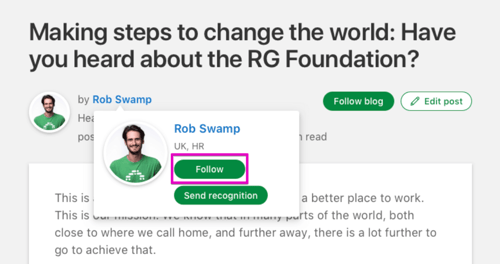According to a study by International Workplace Group (IWG), 50% of Australian employees work remotely for at least half of the week, and more than 2 out of 3 work at least one day away from the office. Year on year, this trend will only continue to rapidly grow along with technology’s speed.
It’s likely your organisation has an ever-growing offline or remote workforce.

These are the employees who live outside of the metro, the field employee whose office is their car or truck, the new mums and dads on parental leave, or the ones who simply aren’t in the office as much as others (think work-from-home employees).
Also consider people who work in restaurants, retail, manufacturing and health services or are on shifts so have little direct communication with their managers and team members outside of the physical workplace.
It’s crucial to your organisation’s success that your communication and recognition initiatives reach employees that do not have a "conventional" work arrangement. If you are looking to foster deeper connections with offline employees why not use the same technology that enables employees to do their jobs away from a typical office.
1. Provide central recognition areas
For employees who don’t sit at a desk all day, or have immediate access to a computer, it’s key to create designated stations for connections.
Provide computer kiosks (whether a desktop, laptop or tablet) in central areas that can be easily accessed by employees.
A break room, meeting room or other shared employee space will work well. As a general rule of thumb, there should be at least one kiosk per location, or one kiosk for every 100 employees.
These kiosks allow your people to take a moment out of their day to access your program to recognise others, catch up on the latest news and join the conversation about the great work going on day-to-day.
This is one way that technology helps improve employee motivation, productivity and engagement to foster a more connected workforce.
.jpg?width=500&name=RG-GBU-36-2018-London_-183%20(2).jpg)
2. Encourage manager participation
Manager participation is a surefire way to increase engagement with your people. If you’ve just implemented a new employee engagement platform, like any type of business software, this should all be included in the training from managers to employees.
It will help them feel comfortable and confident with the basics of logging in, navigating the site, posting recognitions and reading and joining in on the social feed, and importantly it will become embedded as an expected behaviour; something that they should and will do routinely.
Have managers dedicate specific time, where individuals can sign up for 10 to 15 minute windows to virtually walk through using the platform with the manager. They can learn how to log in, submit a recognition post, read posts for any department or group, and like, comment on or share posts.
With remote employees it may make sense to do this weekly, whereas in other situations monthly may be more reasonable. These regular check-ins will do a lot to connect employees to the team, and the added opportunity to remind employees of the online engagement platform will help connect them to the company as a whole.

3. Find your communications champions
Along with encouraging manager participation and offering employees guidance, pick champions to buddy up and help those who are not as comfortable with technology.
For example, for those whose primary language isn’t English, your champions can help them feel more comfortable participating on the social recognition wall or commenting on blog posts by offering examples or helping edit before their peers post.
Your champions are essential to your platform’s and organisation’s success. They should be first in line to help you spread awareness of company news and offer feedback on what’s resonating with their teams. You can even develop a ‘communication group’, ensuring that these members have the tools that they need to assist with sharing the information with their departments and colleagues.
And don’t forget, news and information can come from anywhere. It doesn’t always have to be a leadership member to write articles for the organisations. It is often refreshing to hear updates from people in other areas of the company, employees’ that you might not usually hear from in the call centre or warehouse, or a sales rep in North Queensland.

4. Embrace new ways of doing things
Smartphones are emerging as a useful in-house communication tool for offline employees. Embrace employee engagement mobile trends by introducing apps that can combine communications and recognition and provide a ‘finger on the pulse’ connection for your employees to your business (and to one another) no matter where they are.
Remember the champions we mentioned earlier? They can be a great driver for helping the adoption of these tools, encouraging downloads and frequent visit and assisting others to contribute to the platform.
While it might seem that reading and interacting with these communication platforms are not part of employees core role, it is definitely something that managers should be encouraging. Showing employees that you trust them and that it’s ok to take a break out of their day so they can read, write and comment on recognition stories Help the company as much as the tasks that make up their everyday activity.
Deskless workers should get the same communications as other employees whenever and wherever they want, while also being able to interact with fellow workers even if they aren’t by their side.
What’s more, encourage employees to turn on the program’s alert notifications so they never miss an important company update or immediately know when they’ve been recognised by a peer or their manager. This reinforces the importance of timeliness when delivering a meaningful recognition moment.

5. Tailor messages and communication
Segment employee communications to different groups or teams within the organisation to improve participation, and increase collaboration for employees to stay connected on-the-go. This may mean sending your message at different times or using different media. While that might seem like extra work, once it becomes part of the habit and routine, it will make a significant difference in your engagement levels and is definitely appreciated by those employees.
Here are three different scenarios to help bring this to life:
| 1. Truck drivers: | Who are on the road for weeks at a time, driving across the country who may need a boost in motivation. When they take a break from driving, connect them back to your organisation and team with relevant, attention-grabbing updates. |
| 2. Retail workers: | Who are spread out across many locations, with shifting schedules, who may not get to see their manager every day. Reconnect them to your vision and values through an engagement platform with tailored messages. |
| 3. Nurses: | Who are working in hospitals, helping patients all day long and occasionally working the night shift. Shine a spotlight on their achievements through an engagement platform and amplify these moments with communication. |
Remember, all employees (no matter where they’re located) deserve be aligned and feel connected with their organisation. This means prioritising communicating to an offline workforce to make sure they receive the right messages at the right time.
This sometimes means on their own time – not sitting at a desk, but instead catching up on messages in between long hours of driving, on the night shift or from a cafe. How will you work towards connecting your offline employees?
 Kameel Martin
Kameel Martin

